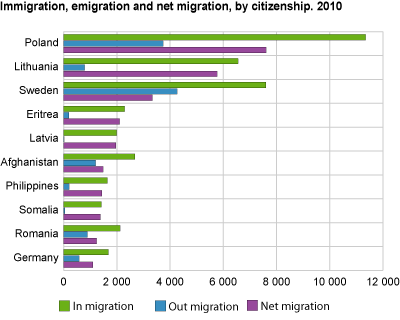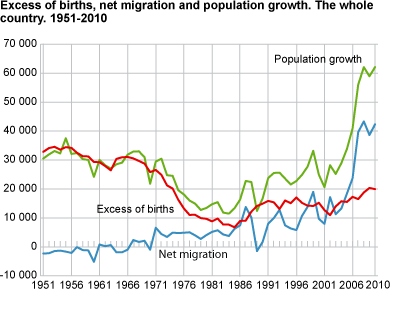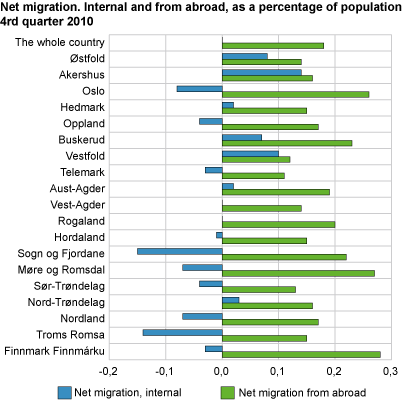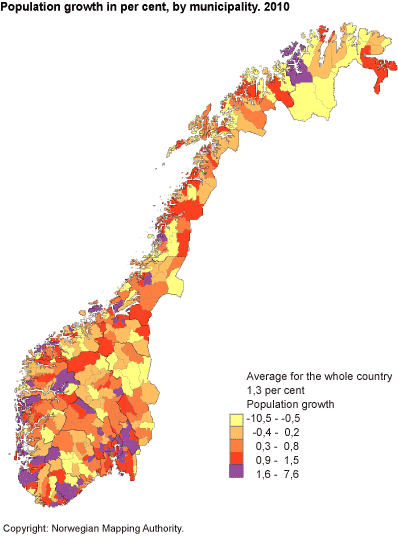Content
Published:
This is an archived release.
Population growth due to high immigration
At the beginning of the year, there were 4 920 300 residents in Norway, which give a population growth of 62 100 or 1.3 per cent in 2010. Immigration surplus accounted for 68 per cent and labour surplus for 32 per cent of the growth.
Population growth increased again in 2010 after a small decline in 2009. Seen in relation to the population there was a population growth of 1.3 per cent. Since 1900, percentage growth has only been higher in 1920 and 2008.
Net migration from abroad increased by 3 700 or 9.6 per cent from 2009 to 2010, and 409 municipalities had a positive net migration. There were 73 850 registered migrations to Norway from abroad in 2010; an increase of 13.3 per cent. A total of 31 500 moved from the country and this is about 5 000 more persons than last year.
|
The population as at 1 January 2011 is now published by sex and age. Figures for municipalities, counties and the country as a whole, distributed by one-year age groups and sex, are available in StatBank Norway. Furthermore, tables containing figures by sex and different age groups for municipalities, counties and the country as a whole are available at “Population statistics. Population by age, sex, marital status and citizenship”. More data will be published on 10 March. In addition to the total numbers for births, deaths and migrations attached to this page, figures for migration by citizenship are available on request. More detailed statistics on births, deaths, internal migrations, and immigration and emigration will be published on 7 April, 14 April and 5 May respectively. Figures are now published for marriages, divorces and separations for counties and the whole country. These are available at “Population statistics. Marriages and divorces”. More detailed information on these topics will be available in August. |
A small decrease in fertility rate, but life expectancy still rises
There were 61 442 children born in 2010; 365 fewer than in 2009. A total of 41 500 persons died; 50 more than in 2009.
Total fertility rate for 2010 was 1.95, while the rate was 1.98 in 2009 and ranged between 1.66 and 1.75 in the middle of the 1980s.
A boy born in 2010 has a life expectancy of 78.85 years (up from 78.60 in 2009), while a girl can expect to be 83.15 years (compared to 83.05 in 2009). This is high compared to the rest of Europe.
Net migration from abroad increased from 38 600 in 2009 to 42 350 in 2010 and is roughly as high as in 2008. The largest surplus consists of citizens from Poland, Lithuania and Sweden, and these are mainly labour immigrants. Thereafter we find citizens from Eritrea, Latvia and Afghanistan. Citizens from Somalia also emigrate to Norway in large numbers. Comparing emigration and immigration, it was mostly Swedes who left the country, 56 per cent, and fewest Latvian citizens, 1 per cent only.
Oslo had the highest population growth with 2.1 per cent and passed the limit of 600 000 in January 2011. It is both the high immigration from abroad and a high excess of births that caused the high population growth in Oslo.
The population in Rogaland and Akershus grew by 1.9 and 1.7 per cent respectively in 2010. In Akershus, the municipalities around the Gardermoen airport grew in particular, with high net migration and high birth surplus. A total of 2 500 more persons moved to than from the county in 2010.
Østfold, with many municipalities located within a convenient commuting distance to Oslo, had high domestic net migration from the rest of the country. The population increased in every county, except for Finnmark and Troms, which had the highest domestic migration loss.
Akershus at domestic net migration top
In relative terms, Akershus had the highest domestic net migration in the 4th quarter by 0.14 per cent in relation to the population at the beginning of the quarter, while Finnmark in the same quarter had the highest net migration from abroad by 0.28 per cent, followed by Møre and Romsdal and Oslo by 0.27 and 0.26 per cent.
Calculated in per cent of the population, Oslo had the highest population growth with 0.39 per cent, while Telemark had the lowest with 0.05 per cent only. Hedmark had the largest birth deficit, followed by Oppland and Telemark, while Oslo and Rogaland also had the largest surplus in the 4th quarter.
The municipalities Osen, Kvitsøy and Skaun had the highest percentages of excess births, while we find Utsira, Engerdal and Etnedal at the bottom of the list with the highest birth deficit.
Tables:
The statistics is published with Population.
Contact
-
Statistics Norway's Information Centre
E-mail: informasjon@ssb.no
tel.: (+47) 21 09 46 42




